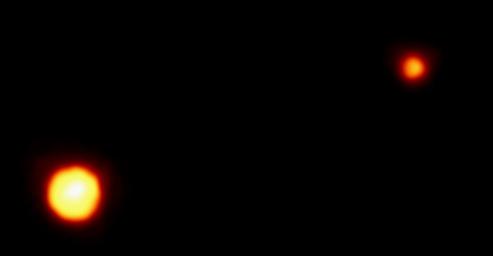
|
Hubble Portrait of the “Double Planet” Pluto & Charon
- Click the image above for a larger view
- Full-Res JPEG (950 x 494) (10.7 kB)
- Full-Res TIFF (950 x 494) (123.4 kB)
Caption:
This is the clearest view yet of the distant planet Pluto and its moon, Charon, as revealed by NASA's Hubble Space Telescope (HST). The image was taken by the European Space Agency's Faint Object Camera on February 21, 1994 when the planet was 2.6 billion miles (4.4 billion kilometers) from Earth; or nearly 30 times the separation between Earth and the sun.
Hubble's corrected optics show the two objects as clearly separate and sharp disks. This now allows astronomers to measure directly (to within about 1 percent) Pluto's diameter of 1440 miles (2320 kilometers) and Charon's diameter of 790 miles (1270 kilometers).
The Hubble observations show that Charon is bluer than Pluto. This means that both worlds have different surface composition and structure. A bright highlight on Pluto suggests it has a smoothly reflecting surface layer.
A detailed analysis of the Hubble image also suggests there is a bright area parallel to the equator on Pluto. This result is consistent with surface brightness models based on previous ground-based photometric observations. However, subsequent HST observations will be required to confirm whether the feature is real.
Though Pluto was discovered in 1930, Charon wasn't detected until 1978. That is because the moon is so close to Pluto that the two worlds are typically blurred together when viewed through ground-based telescopes. (If our moon were as close to Earth, it would be as big in the night sky as an apple held at arm's length). The new HST image was taken when Charon was near its maximum elongation from Pluto of .9 arc seconds. The two worlds are 12,200 miles apart (19,640 kilometers).
Hubble's ability to distinguish Pluto's disk at a distance of 2.6 billion miles (4.4 billion kilometers) is equivalent to seeing a baseball at a distance of 40 miles (64 kilometers).
Pluto typically is called the double planet because Charon is half the diameter of Pluto (our Moon is one-quarter the diameter of Earth).
Background Info:
This image and other images and data received from the Hubble Space Telescope are posted on the World Wide Web on the Space Telescope Science Institute home page at URL http://oposite.stsci.edu/ .
Cataloging Keywords:
| Name | Value | Additional Values |
|---|---|---|
| Target | Pluto | Charon |
| System | Pluto | Kuiper Belt |
| Target Type | Satellite | Dwarf Planet, KBO |
| Mission | Hubble Space Telescope (HST) | |
| Instrument Host | Hubble Space Telescope | |
| Host Type | Space Telescope | |
| Instrument | Faint Object Camera (FOC) | |
| Detector | ||
| Extra Keywords | Color, Moon | |
| Acquisition Date | ||
| Release Date | 1998-03-28 | |
| Date in Caption | 1994-02-21 | |
| Image Credit | Dr. R. Albrecht, ESA/ESO Space Telescope European Coordinating Facility; NASA | |
| Source | photojournal.jpl.nasa.gov/catalog/PIA00827 | |
| Identifier | PIA00827 | |
